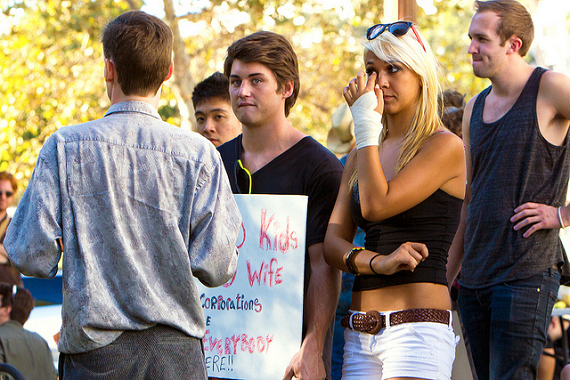
The relationship between "Occupy L.A." and the City of Los Angeles has been a relatively smooth one, at least compared to the one in New York City. Protesters have peacefully assembled on the City Hall Lawn, some sleep on the concrete pathways at night as sleeping on the grass is technically illegal, and arrests have been few and far between. The City Council has even passed resolutions supporting the protesters with somewhat better conditions and verbal encouragement. Some of the Councilmen, first Dennis Zine, Bill Rosendahl and Richard Alarcon, and then others have even wandered "I know its common for protests to happen at Ciclovias?down the steps to talk with Occupy L.A.
But its easy to treat protesters with respect and dignity when there's little to no conflict and the police have easy access to the manpower if a problem should arise. The real test of the city's belief in the right of Occupy L.A. to peacefully assemble will come on Sunday, when CicLAvia stretches the LAPD and tens of thousands of cyclists, pedestrians, skateboarders and other pass right past the protest ground.
Streetsblog has confirmed that the CicLAvia team doesn't want the protesters moved and has communicated this desire to the city, but just in case here is the case to let the protesters stay regardless of how difficult one fears it will be. Just in case anyone is wondering, this list would apply to a Tea Party protest as well.
1) CicLAvia has hosted protests in the past. At the inaugural event last year, there was a gigantic "rally against coal" that was pretty much right where the Occupy L.A. encampment is today. There's a lot of differences between the two protests, but it's not for government to decide which protests are valid and which ones aren't.
2) Ciclovia allows protests that are much larger all the time. Advocates and elected leaders point to Bogota's legendary, weekly Ciclovia as the father of the open streets festivals that are storming North America. Protests are so common at Ciclovia that march and protest leaders actually work hard to schedule protests on Sundays because its cheaper (no permits needed!) and easier than other days of the week.
CicLAvia Board Chair Bobby Gadda has traveled to open streets events around the world. "I know from personal experience its common for protests to happen at Ciclovias," he writes.
3) The protesters are no threat to CicLAvia. The protesters have shown no interest in blocking or disrupting car traffic. There's zero reason to believe they'd be interested in blocking much less intrusive bicycle or pedestrian traffic. If the protesters have a march or something else planned for Sunday, so what? "Whose Streets?"
4) As Elly Blue notes in GRIST, the more embattled version of Occupy L.A. (like the original protest, Occupy Wall Street), rely on bicycles and bicycle riders. To have a giant open street event be used as an excuse to crackdown on a more peaceful version of the New York protests would be a real shame. Heck, some of L.A.'s bicycling groups, the loosely organized Midnight Ridazz, are really looking forward to their chance to show their support for the protest.
5) CicLAvia provides a chance for people to meet, interact with, and learn from the protesters. Coverage of the protest on the nightly news and local newspapers is how most Angelenos know about the protests. Very few people walk or bike past City Hall on a regular enough basis to have actually interacted with Occupy L.A. to learn what their goals really are.
In short, CicLAvia is about the reclaiming of public space as open space. Political protest is as legitimate a use of that space as anything else.






